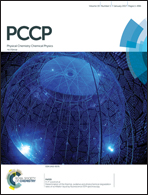Straintronics in two-dimensional in-plane heterostructures of transition-metal dichalcogenides†
Abstract
For in-plane heterostructures between 2D transition-metal dichalcogenides (TMDs), namely, MoSe2/MoS2, MoS2/MoSe2, WSe2/MoS2 and MoS2/WSe2, intrinsic strain can be introduced resulting from lattice mismatch between two constituents, which significantly influences electronic properties (straintronics). Intrinsic strain can reduce or decrease the coupling strength between nonmetal p and metal d orbitals, and therefore modifies the splitting between bonding and antibonding states at the high-symmetry k-points. In this case, relative upward or downward shift of band edge at specific k-points leads to band gap reduction or enhancement and the indirect–direct band gap transition. Upon consideration of spin–orbit coupling (SOC) effects, energy splitting in valence bands will further shift the band edge at a specific k-point, and changes the band gap nature, such as indirect–direct band gap transition. It is of interest that intense states hybridization exists within the interline region, and therefore band alignments for in-plane heterostructures of 2D TMDs should be reconsidered, which is crucial for transport and optical features. In addition, states hybridization plays a role in the amplitude of band edge shift since individual 2D TMDs present different resistance to the strain. However, we found that intrinsic strain has no effects on the SOC-induced energy splitting in valence bands of these in-plane heterostructures, while the extent of states hybridization determines the magnitude of energy splitting. In addition, charge transfer across the interline also has effects on the band gap. In the presence of strain, the bonding strength of two 2D TMDs is reduced.


 Please wait while we load your content...
Please wait while we load your content...